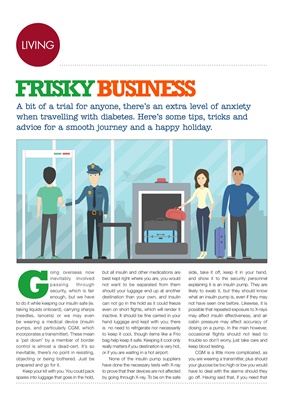
LIVINGLIVING
FRISKY BUSINESS
A bit of a trial for anyone, there's an extra level of anxiety
when travelling with diabetes. Here's some tips, tricks and
advice for a smooth journey and a happy holiday.
G
oing overseas now
inevitably involved
passing through
security, which is fair
enough, but we have
to do it while keeping our insulin safe (ie.
taking liquids onboard), carrying sharps
(needles, lancets) or we may even
be wearing a medical device (insulin
pumps, and particularly CGM, which
incorporates a transmitter). These mean
a 'pat down' by a member of border
control is almost a dead-cert. It's so
inevitable, there's no point in resisting,
objecting or being bothered. Just be
prepared and go for it.
Keep your kit with you. You could pack
spares into luggage that goes in the hold,
but all insulin and other medications are
best kept right where you are, you would
not want to be separated from them
should your luggage end up at another
destination than your own, and insulin
can not go in the hold as it could freeze
even on short flights, which will render it
inactive. It should be fine carried in your
hand luggage and kept with you; there
is no need to refrigerate nor necessarily
to keep it cool, though items like a Frio
bag help keep it safe. Keeping it cool only
really matters if you destination is very hot,
or if you are waiting in a hot airport.
None of the insulin pump suppliers
have done the necessary tests with X-ray
to prove that their devices are not affected
by going through X-ray. To be on the safe
side, take it off, keep it in your hand,
and show it to the security personnel
explaining it is an insulin pump. They are
likely to swab it, but they should know
what an insulin pump is, even if they may
not have seen one before. Likewise, it is
possible that repeated exposure to X-rays
may affect insulin effectiveness, and air
cabin pressure may affect accuracy of
dosing on a pump. In the main however,
occasional flights should not lead to
trouble so don't worry, just take care and
keep blood testing.
CGM is a little more complicated, as
you are wearing a transmitter, plus should
your glucose be too high or low you would
have to deal with the alarms should they
go off. Having said that, if you need that